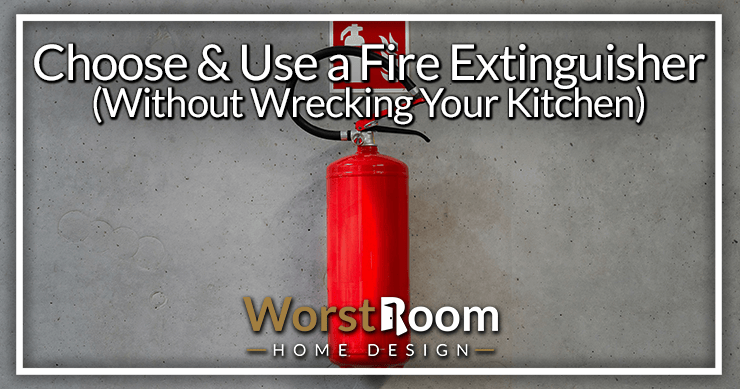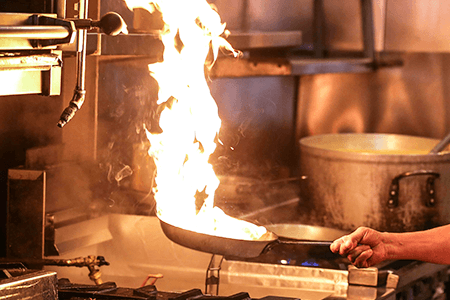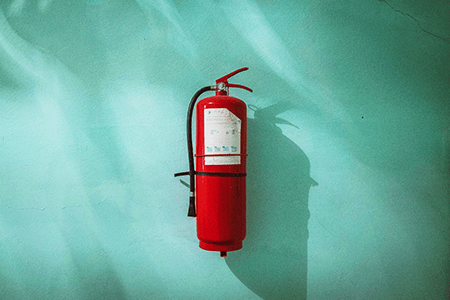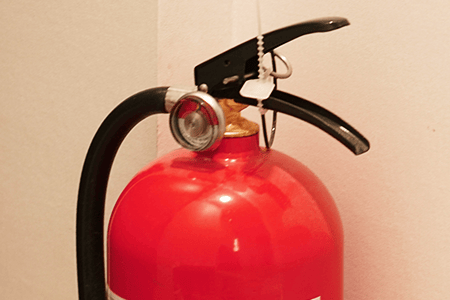How to Choose & Use a Fire Extinguisher (Without Wrecking Your Kitchen)
Author: Anne Cowart | Editor: Omar Alonso
Review & Research: Jen Worst & Chris Miller

Fires are undeniably scary. You might lose your house, valuable belongings, and in the worst cases, your life. Choosing the right fire extinguisher for your home and knowing how to use it is important, especially since some require more cleanup than others.
Understanding the Danger of Fires
Fires are dangerous — in under thirty seconds, they can wreak havoc on homes through spreading uncontrollably and producing toxic, thick smoke. They suck the oxygen out of the air and reach extremely high temperatures. If you experience a fire, leave quickly and get to safety. In some cases, extinguishers eliminate fires, but it is often best to evacuate.
Types of Fires

There are five main classifications of fires, each involving different flammable materials. Understanding these types is essential for fire safety and prevention.
- Type 1: Fires involving ordinary combustibles, like cloth, wood and paper
- Type 2: Fires caused by flammable liquids, such as gasoline or oil
- Type 3: Electrical fires originating from appliances and equipment, like dryers, microwaves or ovens
- Type 4: Fires involving flammable metals
- Type 5: Fires caused by cooking oils and fats, typically in kitchen appliances
The fourth type of fire often occurs in settings like factories, and the last type is a common risk in commercial kitchens.
Choosing a Fire Extinguisher

There are many types of fire extinguishers to choose from, depending on the type of fire that is occurring. A helpful tip is to check the label on the extinguisher for “UL Listed” or “ULC Listed” to ensure it is reputable and has been tested.
Water & Water Mist Extinguishers
When organic solids, like wood, paper or cloth, are on fire, water spray extinguishers are ideal.
Traditional water extinguishers release water when you squeeze the nozzle. They spray along large areas and are easy to maintain. Water is also the least hazardous type of extinguisher.
Water mist is also less dangerous, but it can be more powerful. It sprays a mist of water particles that cools the fire and deprives it of oxygen. The extinguisher itself is recyclable and does not use any chemicals. It removes the heat quickly, diminishing the chances of the fire reigniting.
Foam Extinguishers
You may have seen foam extinguishers often in movies, where the hero dramatically blasts a fire and saves the day. Their primary goal is to smother the fire. The foam leaves residue, so consider this when using it in areas such as the kitchen or living room — that’s the part the action star never has to clean up.
Dry Powder Extinguishers
Dry powder extinguishers smother the fire by forming a crust over it — think of it as a very unappetizing crème brûlee topping. Keep in mind that the powder is toxic and the fire may reignite, since dry powder does not cool the surface. Both dry powder and foam extinguishers require significant cleanup afterward.
Carbon Dioxide Extinguishers
The last two types of extinguishers are carbon dioxide and wet chemical. Carbon dioxide extinguishers use only carbon dioxide gas, leaving no residue behind. However, the nozzle can become extremely cold during use, so avoid touching it directly.
Wet Chemical Extinguishers
These extinguishers are more common in commercial kitchens. Wet chemical cools flames and prevents the splashing of hot grease by using potassium salts in a mist form. When the wet chemical agent comes into contact with the hot cooking oil, it turns the fat into a soapy, foam-like substance. This soapy layer creates a barrier between the hot oil and the oxygen in the air, effectively smothering the fire and preventing it from reigniting.
Multipurpose Extinguishers
An additional type of fire extinguisher combines several of the above types. Multipurpose extinguishers that cover common household fires are ideal, since they eliminate the need to own multiple types. They may leave residue, so keep that in mind as well.
Using Your Fire Extinguisher

Fires are not common, per se, but they do happen. Only around 26% of families in the United States have a proactive plan in place in case of a house fire.
Before using an extinguisher, ensure that the residents of the house are aware of a fire and that someone has called the fire department. Proper training is also a must. If the fire is contained and you have a clear exit route, then you can use the extinguisher. Avoid inhaling the toxic smoke. If you are still unsure, evacuate safely and let the firefighters handle it.
The best way to operate a fire extinguisher is a method called PASS, which stands for pull, aim, squeeze and sweep. To use PASS, you should:
- Pull the pin while keeping the nozzle pointed away from your body to release the lock.
- Aim low. The bottom of the fire is most effective.
- Squeeze the lever. You want a slow and even stream.
- Sweep the nozzle from side to side to cover the entire fire.
Stay calm and do not panic. You are less likely to make beneficial decisions if your mind is turned off with fright.
Maintaining Your Fire Extinguisher
If a fire extinguisher is not regularly checked, it may not work correctly in an emergency. Ensure it is reachable for quick access. Check the gauge for the correct pressure level, and recharge or replace it if necessary.
Look for any damage, such as dents or rust on the pieces of the extinguisher, like the cylinder, hose or nozzle. Clean it regularly. Dust, oil and grease can build up on the outside of it. Some need to be shaken periodically, so consult the guidelines to see if yours does.
Protect Yourself Against Fires
Choosing the right extinguisher and knowing how to operate it are key to using it effectively. Ultimately, fire safety is about being proactive. By understanding the risks, having the correct equipment ready, and knowing when and how to act, you empower yourself to handle a small fire emergency. This preparation, combined with a clear evacuation plan, forms a comprehensive safety strategy to protect your home and loved ones.




